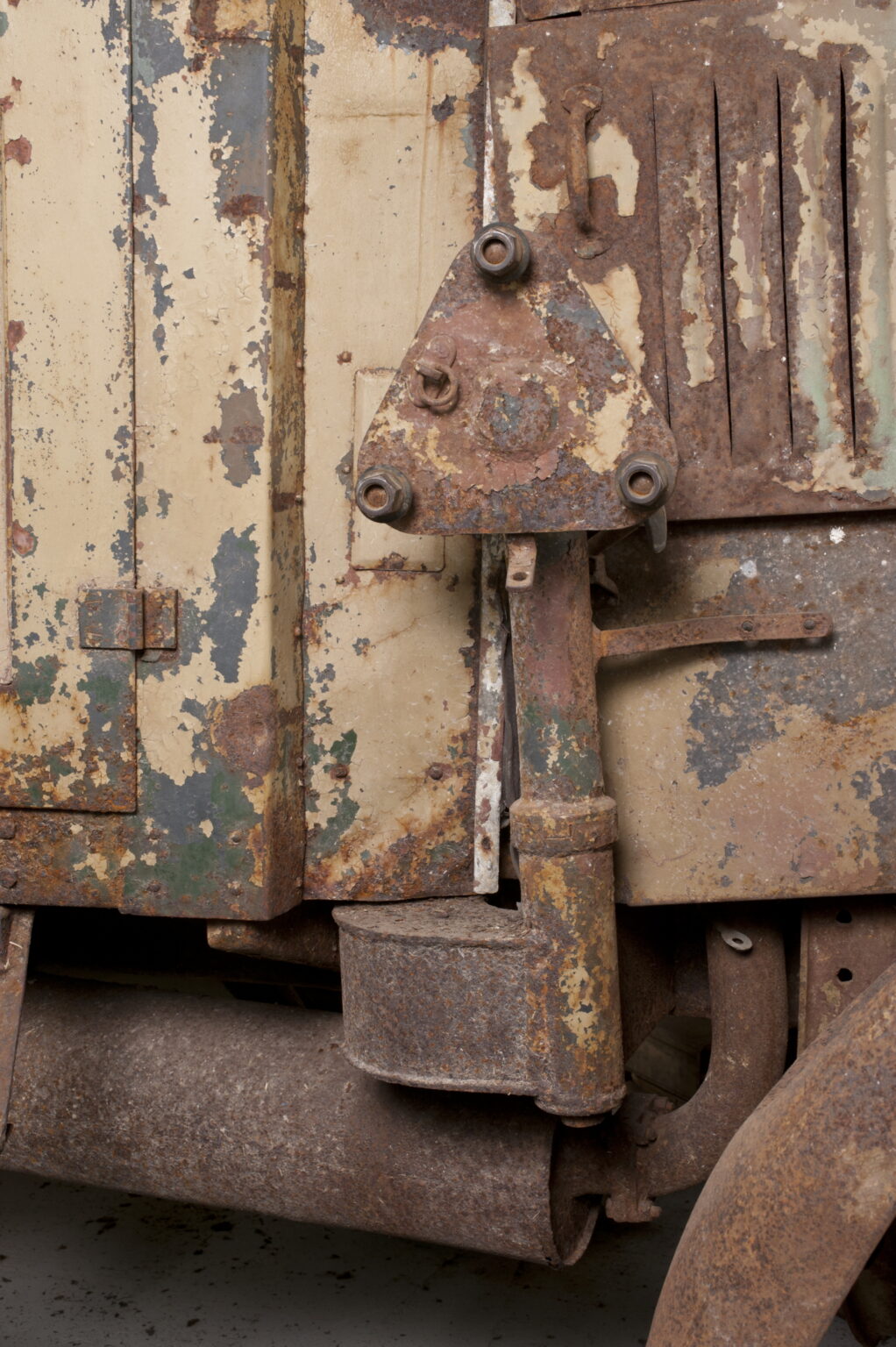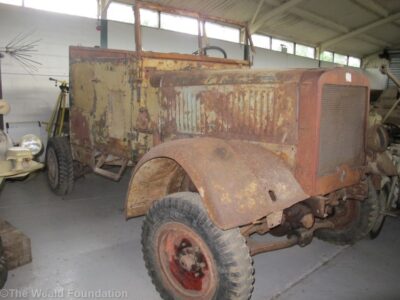Normandy in November 2007. An auction was held to dispose of the renowned collection belonging to the fabled Alain Roudeix. The event drew in every dealer and collector from across Europe and beyond.
For years Roudeix had scoured the Norman countryside near his home amassing an impressive collection of vehicles and parts, left over from the catastrophic rout of the German army at the end of the Normandy campaign. His home town of Vimoutier lay in the so-called ‘corridor of death’, through which the shattered remnants of the German army retreated from the Falaise Pocket.
Roudeix used to entertain with his magnificent– and enormous– collection of scrap, parts, complete objects and vehicles in dire need of care and attention.. In his many old, low corrugated iron buildings one could see his massive haul of parts, wire, armour, wheels and vehicles: a Schwimmwagen propeller rod, an original Sd.Kfz.251 air filter, Schürzen (armoured skirt) sections for StuG IIIs, magnetos for numerous vehicles and countless ‘Tiger’ items. So large was his collection that it spilt out of these sheds.
We found a Horch maintenance truck and our six-wheeled Einheitsdiesel outside. He used to entertain too, with his stories and photographs. He told visitors of his discovery and cosmetic restoration of the ‘Vimoutier’ Tiger, and of his time during and after the war in Normandy. His most incredible story though, retold on every visit, was when he witnessed the strafing by a Spitfire of Field Marshal Rommel, in his Horch staff- car, on a road leading down to his house in 1944. His enthusiasm for the story never diminished and his description of the aftermath seeing Rommel lying there was riveting.
His enthusiasm faded when you attempted to raise the possibility of a sale of one or two items in his collection. He was, in fact, famed for his reluctance to sell in the dealer community. The usual answer was ‘come back next time’. We managed to secure an Sd.Kfz.251 air filter and two very good magnetos for the StuG. The Einheitsdiesel was always a no and if you were lucky enough to elicit a price it was very, very high. Visits over a fifteen-year period inevitably produced the same response but provided further opportunity to survey the truck. The condition of the vehicle deteriorated as each year passed. The tarpaulin covering the truck, initially new, was increasingly threadbare and provided little if any protection to the truck. What was once in superb condition, save for the missing rear axle and rear cargo bin was rotting away.
News of M. Roudeix’s death and the planned auction of his collection quickly travelled through the collector community. Everyone we spoke to planned attending this sale of a lifetime. The Einheitsdiesel truck was reason enough for us to attend. This was the first time in 15 years we had the opportunity to purchase the vehicle at market price. The price was a potential issue as many people were planning to attend the auction. Thankfully, however, the truck was not on most people’s radars. Over the years we had been asked many times— why an Einheitsdiesel? It doesn’t drive very well. It has a pig of a steering wheel and no power steering— It was, as the German soldiers of the day called it, “Eiserne Schwein”– ‘Iron Pork.’ We had seen and been offered other Einheitsdiesels over the years, but we had to have M. Roudeix’s and the history behind it.
Viewing of the whole collection took place on the day prior to the auction. Large numbers turned up for the event. The less scrupulous attendees immediately began to hide unique and valuable parts in otherwise unexceptional heaps of scrap. This was only the beginning of this opportunity of a lifetime. We returned to our bed and breakfast late in the evening after having had a good look around and identified potential lot numbers.
The next morning saw an even bigger crowd and finally security for the first time. No one was permitted to enter until a few minutes before the start of the auction. The signal went out that the show was about to begin and we were permitted to take our seats. Standing room only for those too slow on their feet and for late arrivals no room at all. A French auction house was in charge of the proceedings with translations provided for the Anglo-Saxon and Eastern contingents. Prices were very high and our truck was still some time off so we opted to retire to the local hotel bar for refreshment and to ponder strategy.
We had checked out who was there, who was real and who were the tyre kickers. We had also sounded out who was interested in what – no one had showed or voiced any interest in the reason for our attendance - so far so good. The truck sale was planned to take place after lunch. We had worked out the timing of each lot and had a pretty good idea of how much longer we had to enjoy our lunch.
Our truck arrived and we were pleased to note our intelligence gathering had been accurate. The initial bidders fell away leaving only ourselves and a mystery bidder in England competing for the Einheitsdiesel. The price continued to rise, beyond the level we had estimated earlier. The time taken to decide by the mystery telephone bidder was interminable. Each price level became more and more laborious but we were still within the value range for the vehicle. The other bidder eventually fell away and the vehicle was ours. The problems were yet to begin. We had no idea payment had to be in cash. No cards or cheques. One of our friends accompanying us kindly lent us the necessary funds to settle the deal. Given what had been going on the day before the auction we decided to move the truck that night to a secure location.
The fruits of fifteen years persistence would be shipped back to England a few days later.
During the evening, once the public had left the auction a free for all ensued in the hall where everything had been left pending collection the next day. The gate was not being policed and in a short time many parts were gone. One friend of ours turned his back to talk to someone only to find, on turning back around, that a Schwimmwagen propeller on his pallet had gone. The next morning another person discovered that the majority of the original boxes he had bought had disappeared. We learned a good lesson from all of this – leave nothing overnight. Others discovered that items had been lost even prior to the auction and what they thought they were bidding for was no longer there after purchase.
With the arrival of the Einheitsdiesel in England we had the chance to fully inspect our purchase. The vehicle was in what appeared to be very original battlefield condition. Water canteens were still in the foot well of the passengers side. There were numerous perforations caused by shrapnel and gunfire in the cabin wall on the left hand side. A telling shot had been fired through the firewall just below the windscreen frame. Judging by the angle and size of the hole it appeared to be round from an aircraft.
Clear remnants of a number of generations of loading stencils were visible one above the other. The layers of paint and camouflage, matching the loading stencils were also apparent. The dark blue grey, dark green of the Reichswehr, the pre April 1943 grey of the Wehrmacht and the later overspray of dark yellow ‘Dunkelgelb ’ leading up the end of the vehicles’ military career in late summer 1944 were all present.
The wings and bonnet are in good redeemable shape all retaining enough of the original dark yellow and camouflage pattern to match the cabin. The engine and mechanicals will require much work given the impact of M. Alain Roudeix’s scanty tarpaulin and storage facilities. The radiator shroud will probably not pass muster given the rust damage. The radiator grill should make it. We were fortunate in being able to secure two spare rear axles from a collector here in England. The rear cabin body will have to be sourced when the time comes to start the project.
The chassis number has not yet been located. The three letter code for the engine manufacturer is dhn. This appears to be Kämper Motoren A.G of Berlin Marienfelde. The original aluminium shield, positioned on the inside of the drivers door, bears the letter sequence alongside the Kraftfahrzeug column heading L G LKW and then what appears to be WH 717752. The full version of L G LKW is leichte geländegängiger Lastkraftwagen. Light cross-country truck. No further research has been done at this point. We assume for the present that this truck was the standard transport version with a steel cargo body behind the cab.
- This article has 1496 words
- Reading time: 7 minutes
- There are no photos
Become a Member - Access the Full Article
Members gain access to the full content of our articles, including photo galleries.


